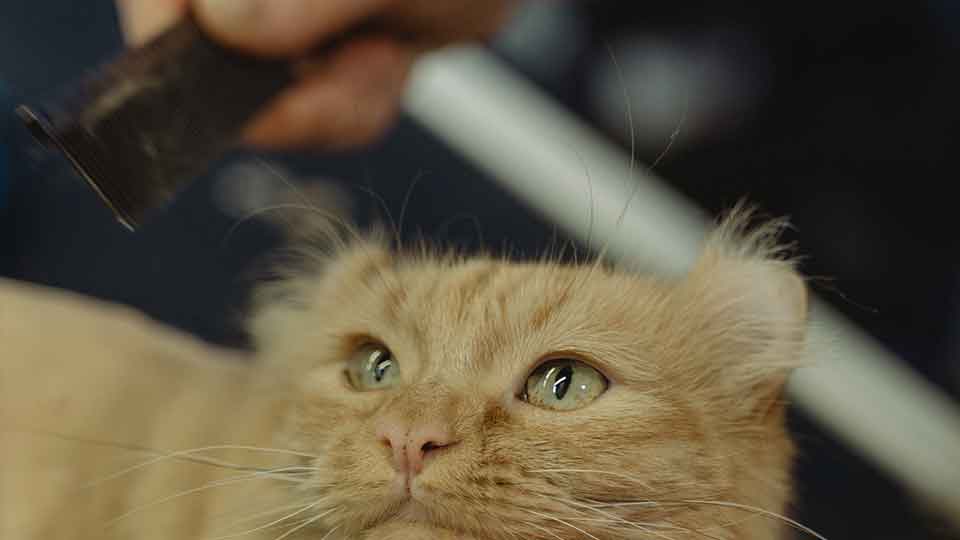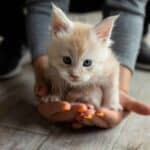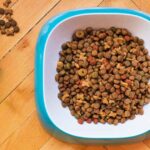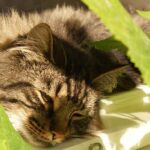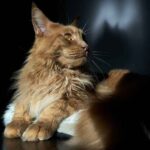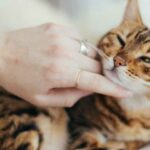Cat shedding is not necessarily a problem, as it is a natural and healthy process for cats to renew their coat and adapt to the changing seasons.
However, cat shedding can become a problem if it is excessive, irregular, or caused by an underlying health issue.
If you own a Maine Coon cat, you may wonder how to deal with their long, thick, and fluffy coat that seems to shed everywhere.
In this blog post, I will answer some common questions about Maine Coon shedding and give you some tips on how to stop or reduce it.
Why Do Cats Shed Hair?
Shedding is a natural process for cats and other mammals.
It is a way of getting rid of old, damaged, or excess hair and making room for new, healthy, and appropriate hair.
Cats shed hair as part of their hair growth cycle, which consists of four phases: anagen (growth), catagen (transition), telogen (rest), and exogen (shedding).
Each hair goes through these phases at different times, so cats shed continuously throughout the year.
External factors such as temperature, sunlight, nutrition, health, and stress influence shedding.
Cats tend to shed more in spring and fall when they adjust their coat thickness and length to the changing seasons.
Indoor cats may shed less seasonally and more evenly throughout the year as they are exposed to artificial lighting and heating that affect their hair cycle.
Cats may also shed more when malnourished, sick, or stressed.
Shedding is normal and healthy for cats, as it helps them maintain a clean and comfortable coat.
However, excessive shedding can indicate a problem, such as allergies, parasites, infections, hormonal imbalances, or skin disorders.
If your cat is shedding more than usual, has bald patches, or shows signs of itching, scratching, or irritation, you should consult your veterinarian.
When Do Maine Coon Cats Shed?
Maine Coon cats are known for their long and luxurious coat that consists of two layers: a soft and dense undercoat that provides insulation and a coarse and water-resistant overcoat that protects them from the elements.
Maine Coons originated in Maine, where they had to adapt to harsh winters and cold climates.
Their coat is one of the distinctive features that helped them survive in their natural environment.
Maine Coon cats tend to shed seasonally, typically twice a year: once in spring and once in fall.
During these times, they lose their undercoat and change their coat density and length according to the weather.
They shed their thick winter coat in spring to prepare for the warmer summer months. In fall, they shed their light summer coat to grow a new winter coat that will keep them warm and cozy.
However, not all Maine Coon cats shed the same way or at the same time.
Some factors that may affect their shedding pattern are:
• Their living conditions: Indoor Maine Coons may shed less seasonally and more evenly throughout the year than outdoor Maine Coons, as they are less exposed to natural temperature and light changes.
• Their genetics: Some Maine Coons may have courser or finer hair than others, which may affect how much they shed. Some may also have different color patterns that may influence their shedding cycle.
• Their age: Younger Maine Coons may shed more frequently than older ones, as they are still growing and developing their coat. Older Maine Coons may shed less often but more heavily than younger ones.
• Their health: Maine Coons with health issues such as allergies, parasites, infections, hormonal imbalances, or skin disorders may shed more than normal or have irregular shedding cycles.
Do Maine Coon Cats Shed A Lot?
Maine Coon cats do not shed more than other breeds of cats.
In fact, some breeds such as Persians or Himalayans, may shed more than Maine Coons due to their longer and finer hair.
However, due to their large size and thick coat, Maine Coon shedding may seem more noticeable than other breeds.
Maine Coon shedding can be a nuisance for some owners who have to deal with fur all over their furniture, clothes, floors, and carpets.
It can also be a health concern for some people with allergies or asthma triggered by cat dander or saliva.
Moreover, it can be a problem for the cats if they ingest too much hair while grooming themselves, which can cause hairballs or intestinal blockages.
How To Stop Maine Coon Cats from Shedding?
You cannot stop your Maine Coon cat from shedding completely.
Shedding is a natural and healthy process for your cat that you should not interfere with.
However, you can reduce the amount of shedding and its impact on your home and your health by following some simple tips:
• Brush your cat regularly
This is the most effective way to reduce shedding and keep your cat’s coat healthy.
Brushing removes loose hair before it falls out and distributes natural oils throughout the coat.
It also prevents mats and tangles that can cause skin irritation or infection.
You should brush your Maine Coon cat at least once a week, preferably with a metal comb and a soft bristle or rubber brush.
You may need to brush more often during the shedding seasons or if your cat has a lot of fur or mats.
Be gentle and patient with your cat and reward them with treats and praise for being cooperative.
• Bathe your cat occasionally
Bathing can help remove dirt, debris, and excess hair from your cat’s coat.
It can also moisturize and soothe their skin, making their fur softer and shinier.
However, bathing is unnecessary for Maine Coons, as they are very good at keeping themselves clean.
You should only bathe your cat when they are dirty, smelly, or have a skin condition that requires a medicated shampoo.
You should also use a mild and gentle shampoo specially formulated for cats and avoid getting water in their ears, eyes, nose, or mouth.
You should also dry your cat thoroughly with a towel or a hairdryer on a low setting and comb their fur afterward to prevent mats.
• Feed your cat a high-quality diet
Your cat’s diet is vital to coat health and shedding.
A balanced and nutritious diet that provides enough protein, fat, vitamins, minerals, and omega-3 fatty acids can help your cat maintain healthy skin and coat and reduce shedding.
You should avoid cheap or low-quality food that contains fillers, by-products, artificial colors, flavors, or preservatives that can cause allergies or digestive issues.
You should always provide your cat with fresh water to keep them hydrated and prevent dehydration that can affect their skin and coat.
• Keep your cat parasite-free
Parasites such as fleas, ticks, mites, or worms can cause your cat to scratch, bite, or lick their skin excessively, leading to hair loss, inflammation, infection, or anemia.
You should check your cat regularly for any signs of parasites and treat them promptly with the appropriate medication.
You should also use preventive measures such as flea collars, spot-on treatments, or oral medications to keep your cat protected from parasites.
Keep your cat’s environment clean and free from potential sources of parasites such as other animals, plants, or soil.
• Reduce your cat’s stress
Stress can affect your cat’s physical and mental health and cause them to shed more than normal.
Stress can be caused by various factors such as changes in the environment, routine, or family members; lack of attention or stimulation; boredom or loneliness; illness or pain; or conflicts with other pets.
You should identify the source of stress for your cat and eliminate it or minimize it as much as possible.
Provide your cat with a safe, comfortable space to relax and feel secure.
You should also spend quality time with your cat every day and play with them, cuddle them, talk to them, or groom them to make them feel loved and happy.
How Often Should You Brush A Maine Coon Cat?
Brush your Maine Coon cat at least once a week to keep their coat healthy and reduce shedding.
However, you may need to brush more often depending on the following factors:
• The length and texture of your cat’s fur: Longer and finer fur tends to shed more and get matted more easily than shorter and coarser fur.
If your Maine Coon has long or fine fur, you may need to brush them two to three times a week or even daily during the shedding seasons.
• The presence of mats or tangles: Mats are clumps of hair that are tightly knotted together and can cause pain, discomfort, skin irritation, or infection for your cat.
Tangles are loose knots that can lead to mats if not removed promptly.
If your Maine Coon has mats or tangles in their fur, you may need to brush them more frequently until you get rid of them.
You may also need to use scissors or clippers to cut out stubborn mats that cannot be brushed out.
• The season: Maine Coons shed more in spring and fall when they change their coat thickness and length according to the weather.
During these times, you may need to brush them more often to remove the excess hair and prevent mats.
• Your personal preference: Some owners may prefer to brush their Maine Coon cats more often than others for aesthetic reasons or to reduce the amount of hair in their home.
Some cats may also enjoy being brushed more than others and see it as a bonding activity with their owners.
The bottom line is that you should brush your Maine Coon cat as often as they need it and as often as they tolerate it.
Brushing benefits not only their coat health and shedding but also their overall well-being and happiness.
Final Thoughts
Maine Coon cats are beautiful creatures that have long and thick coats that require regular grooming and care.
Shedding is a normal part of their hair cycle that helps them adapt to the changing seasons and maintain a clean and comfortable coat.
However, shedding can also be a nuisance for some owners who have to deal with fur all over their furniture, clothes, floors, and carpets.
It can also be a health concern for some people with allergies or asthma triggered by cat dander or saliva.
Moreover, it can be a problem for the cats if they ingest too much hair while grooming themselves, which can cause hairballs or intestinal blockages.
Fortunately, there are some ways to stop or reduce Maine Coon shedding and make it more manageable for both you and your cat.
The most important thing is to brush your cat regularly with the right tools and techniques to remove loose hair and prevent mats.
You should also bathe your cat occasionally with a mild shampoo to clean their fur and skin.
And feed your cat a high-quality diet that supports their coat health and keeps them parasite-free and stress-free.
FAQ
At what age do Maine Coons grow the most?
Maine Coons grow the most during their first year of life, gaining about 0.25 pounds (100 g) per week for several months.
They reach their full adult size and weight by the time they are 3 to 4 years old, but some may continue to grow until they are 5.
Do Maine Coons get fluffier with age?
Yes, Maine Coons get fluffier with age as their coats mature.
Their coat consists of two layers: a soft and dense undercoat that provides insulation and a coarse and water-resistant overcoat that protects them from the elements.
Their coat length and thickness vary according to the season, with a thicker and longer coat in winter and a thinner and shorter coat in summer.
Their coat also varies according to their genetics, age, health, and grooming habits.
Some of the fluffiest parts of a Maine Coon are their tail, mane, and inner ears.

